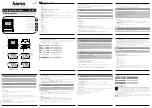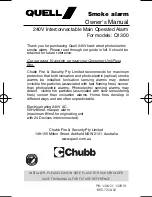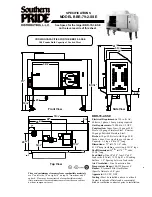
FlammEx CO Alarm (carbon monoxide)
Please read carefully and retain!
In buying this item you have opted for a high-quality FlammEx product. Please read these
user instructions carefully to ensure the device is used correctly. Keep them in a safe place
for future reference. Use this product only as intended (as set out in the user instructions).
Any changes or modifications to the product or painting it will result in loss of warranty.
Correct working order is not guaranteed in this case.
1. What you need to know about carbon monoxide (CO)
Carbon monoxide (CO) is an insidious poison. It is a gas that has no colour, smell or taste. CO
gas is formed from the incomplete combustion of materials containing carbon, namely when
there is insufficient oxygen for such materials to burn properly. This danger can arise with
central-heating boilers, open fireplaces and car exhausts. The poison accumulates in the
blood and obstructs the passage of oxygen, which can lead to death from suffocation.
Even small concentrations of CO gas can cause brain or organ damage in unborn babies
without the mother being affected.
Symptoms of carbon monoxide poisoning include:
Mild indications
Stronger indications
Extreme indications
• Slight headache
• Severe headache
• Unconsciousness
• Nausea/vomiting
• Drowsiness
• Cramps
• Tiredness
• Confusion
• Irregular heartbeat
• High pulse
• Death
2. Important information
The installation should only be carried out by a competent person. CO alarms are
not a substitute for smoke, fire or other alarms. This alarm is only intended for use in
private residential properties. It is not suitable for commercial or industrial applications,
nor for use on boats or ships, whether leisure or working craft. The following materials
may have a lasting adverse effect on the device’s correct operation.
Therefore, always keep the device away from:
• Ammonia gas/ammonia solutions • Paint brush cleaners • Paint thinners • Cellulose thinners
It cannot offer people requiring special medical treatment complete security, and cannot
prevent the chronic effects of carbon monoxide on the human body (see also EN 50292:2001,
Annex A). It is not a replacement for the correct installation, use and maintenance of fuel-
burning systems including associated ventilation and gas flue systems.
The FlammEx CO alarm must be replaced after approx. 5 years. Closely follow the instructions
provided in this user guide when installing your FlammEx CO alarm.
Note that there are other dangers where this alarm’s ability to detect carbon monoxide will not
help you, e. g. in the event of gas leaks, fire or explosions. For such dangers we recommend
our FlammEx gas, smoke and heat alarms. You can find more information about these on our
website.
3. What to do when the alarm sounds
1. Head immediately for fresh air. Go outside or to an opened door or window.
2. Call the fire brigade.
3. Do not re-enter the affected area/do not move away from the opened window
or door.
4. Wait for the fire brigade to arrive.
5. Thoroughly ventilate every room.
6. When danger no longer exists, the FlammEx CO alarm will reset itself
automatically and return to its normal working mode.
4. Installation and first use
Recommended installation for optimum safety:
Install a CO alarm in every bedroom and in all rooms with gas heating, stoves/ovens or
open fireplaces, plus in the hallways on every floor and in any basement garage.
Recommended installation for basic protection:
Install a CO alarm in hallways and in rooms with gas heating, stoves/ovens and/or open
fireplaces.
Mounting location
Fit the alarm near to the source of danger (e. g. gas boiler) at a height of at least 1.5 m
(picture 2)
.
Installation and first use:
1. Take off the mounting plate by holding the alarm firm and turning the plate anti-clockwise.
2. Once you have worked out the correct place to mount the alarm
(pictures 1 - 4)
, fix the
mounting plate horizontally to the wall using the wall plugs and screws provided
(picture 5)
.
3. Open the battery compartment by pressing the release
(picture 5a)
while at the same time
sliding the compartment cover downwards
(picture 5b)
. Insert the 3 batteries
the right way
round
(picture 6)
and make sure that the red pins are in contact with each battery.
The alarm confirms that the batteries are in place with a short beep and all 3 LEDs
(picture 5c)
light up briefly. After a few seconds the yellow Fault LED will light up
continuously.
4. Place the alarm on the mounting plate to complete the activation process. If this does not
happen, after a delay of 5 – 6 minutes the alarm will start to beep every 60 seconds
(see 5. Table of functions
). Turn the alarm clockwise until it clicks into place. The yellow
Fault LED will go out and the beeping will stop
5. Close the battery compartment by replacing the cover and sliding it upwards until it
clicks in.
6. Test the alarm straightaway by pressing the
Test/Mute button
(see 6. Maintenance/
Testing the alarm, and picture 5b)
.
5. How the alarm functions
The alarm is equipped with a battery monitoring system. Low batteries are indicated by the
alarm starting to beep and the yellow
Fault LED (picture 5c)
flashing around every
6
7
D
GB
F
NL
I
S
RUS
PL
SK
CZ
H
Summary of Contents for 003929
Page 2: ...1 2 3 4 c a b 1 2 5 6 7 ...






































